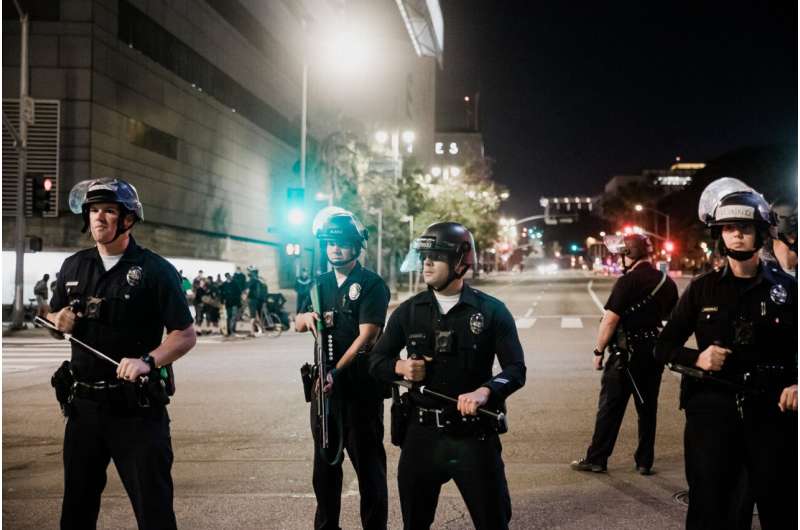This article has been reviewed according to Science X's editorial process and policies. Editors have highlighted the following attributes while ensuring the content's credibility:
fact-checked
peer-reviewed publication
trusted source
proofread
Hard-right social media activities lead to civil unrest, says paper

Does activity on hard-right social media lead to civil unrest? With the emergence and persistent popularity of hard-right social media platforms such as Gab, Parler, and Truth Social, it is important to understand the impact they are having on society and politics. Previous research on the relationship between social media use and subsequent offline behavior has been ambiguous. While some studies have found that social media influence social attitudes, other research argues that using social media has little effect on users' opinions and behaviors.
In their new study, "'Born for a Storm': Hard-Right Social Media and Civil Unrest," appearing in the April 2023 issue of The American Sociological Review, authors Daniel Karell, Yale University; Andrew Linke, The University of Utah and Peace Research Institute Oslo (PRIO); Edward Holland, University of Arkansas; and Edward Hendrickson, independent scholar, seek clarity on this crucial question. A version of their paper is available on the SocArXiv preprint server.
The authors define hard-right social media (HSRM) as similar to alternative social media platforms, or "alt-tech," but with some important distinctions. Alt-tech platforms stand in opposition to mainstream platforms, typically by offering different governance structures and/or speech moderation policies. Some examples are Ello, Gab, and Mastodon. HRSM share these core features, but also have two characteristics distinguishing them from the rest of the alt-tech universe.
First, their content is primarily socially and politically conservative—and, often, more uncompromising than other conservative perspectives. Second, whereas most alt-tech platforms, especially early on, resisted the profit-seeking motive of more mainstream platforms, HRSM companies usually seek profit—for example, by selling advertisements, memberships, and financial products, as well as promoting affiliated conservative media elites and organizations.
The authors drew on three kinds of data. First, they used hard-right civil unrest event data covering the United States from January 2020 through January 2021. These data were collected from two sources of event records, the Armed Conflict Location and Event Data project and the Crowd Counting Consortium. Second, the authors collected activity data from the HRSM platform Parler from across the United States throughout 2020. Finally, the authors drew on an original database of video content that Parler users shared during 2020. They combined the datasets by U.S. Census statistical regions countrywide.
The authors found that HRSM activity did indeed increase subsequent unrest in the United States during 2020. Their results indicate that that a 10 percent increase in HRSM activity predicts a .04 percent increase in the number of hard-right civil unrest events during the following month (per 100,000 people). This estimate reflects a countrywide pattern. Numerous robustness checks, placebo tests, quasi-experimental analyses, and sensitivity analyses supported this finding.
Furthermore, the authors found evidence that social media can shift people's understanding of appropriate social norms, creating "mis-norms." HRSM affected users' perceptions of social norms, such that users came to view participation in hard-right unrest as more acceptable than they once thought, thereby making offline unrest more likely after HRSM activity. "Hard-right-specific social media platforms are becoming more popular among the political right," note the authors, "and attracting billions of dollars of investment. A robust, well-financed, and broadly influential U.S. HRSM ecosystem is emerging, and our findings offer a glimpse into its future."
One avenue that authors suggest for possible future research is to examine politically leftist social media content and activity, which may cause corresponding contentious events. Although the authors do not examine this possibility because their data limit them to studying HRSM, they suggest that "although leftist social media are not currently undergoing a 'strategic exit' like the online right, de facto isolation may emerge on mainstream platforms as conservative social media users migrate to HRSM platforms."
Another avenue for future work is to consider how specialized social media platforms, both HRSM and left-leaning niche platforms, create "mis-norms." Future work could develop this idea further, including the process by which people adopt mis-norms and comparing how mis-norms affect offline behavior.
More information: Daniel Karell et al, Hard-Right Social Media and Civil Unrest, SocArXiv (2021). DOI: 10.31235/osf.io/pna5u
Daniel Karell et al, "Born for a Storm": Hard-Right Social Media and Civil Unrest, American Sociological Review (2023). DOI: 10.1177/00031224231156190 , dx.doi.org/10.1177/00031224231156190
Journal information: American Sociological Review
Provided by American Sociological Association





















